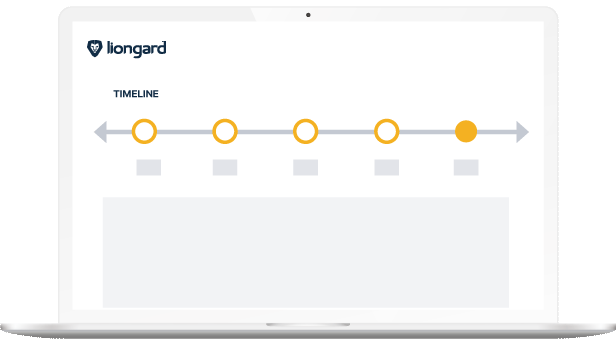Manual Processes Mean More Room for Error
With so many information systems to manage, simple things can get overlooked, no matter how many checklists and procedures you put into place. With Liongard's library of over 300 IT alerts for managing critical systems, you can finally feel confident you're on top of every detail, every time.
That means you have an IT alerting system to take human mistakes out of the equation. Our monitoring tools also free up your IT services desk to handle critical interactions, such as a website outage or system failure, without the burden of an overloaded inbox.
Better alerting can let your staff know about outages and restarts that interrupt workflow. Your IT team's response times should also improve with a more efficient incident management plan.
Set IT Alerts for Any System
A comprehensive library of alerts across the stack lets you monitor critical systems, users, or changes. That gives you the convenience of creating an IT alerting system that works for your company. Enjoy the freedom of setting your own alerts and monitoring tools to track incidents and prioritize action items. Alerts vary in their importance and spectrum; shouldn't your monitoring system offer that same flexibility?
Create & Customize Alerts To Fit Your Needs
An alerting system is not a one-size-fits-all tool. What works for one company may not offer the services you want or provide a tiered-access system to alert pertinent staff rather than sending out a mass notification. With Liongard, you can pinpoint any piece of data from any system and create specific thresholds you want to alert on. When you automate your custom monitoring system, you can enjoy features that resolve critical issues and give your staff the time to focus on other important responsibilities.
View Alerts Where You Want
How do you prefer to communicate with your staff? Do you rely on standard platforms, SMS, or other outdated alerting systems? With Liongard, you choose the alerting tools that fit your process to make sure no actionable alert goes unnoticed. Full loop service ticket integrations are available with Autotask, ConnectWise, or email.
IT Alerting Helps MSPs Work Smarter
MSPs work as extra teams to assist your IT department. If they do not connect with your staff or follow protocol, actionable alerts could fall through the cracks. When you create customized alerts, you can build the infrastructure you need by categorizing alerts and monitoring response times.
Creating an Effective IT Alerting Strategy
An IT alert system is a no-brainer to improve your vendor experience and communicate more effectively throughout your business. See how alerting breaks down to keep your teams on task.
IT Alerting Attributes
Consider your communications hub as the central brain of your operation. It functions as part database and part dashboard to help you track your server, generate reports, note incidents, or set new functions for helpful alerting.
Alerts exist for a reason, and it’s imperative that your teams don’t overlook them. To ensure that your customers or teams see this content, alerts can persist at determined intervals until the issue resolves. Additionally, you can set up persistent alerts until your teams read them and respond. The goal is faster action from alerts that your teams no longer overlook.
Normally reserved for incident teams or triage, abnormality alerting can focus on system failure, incident crisis, or anything else out of the ordinary. This kind of alerting can stop you from wasting time with a restart that just slows down productivity. With an elevated alert, you have monitoring capability for notification receipt and review.
If every alert carries the same weight, how will your staff know what is outstanding and what is completed? With prioritized alerting, you decide which alert to escalate and which general notifications to automate. A priority database of SMS, voice, or email alerting can help your company communicate smarter. It's also a useful tool to keep track of each lead and resolve each incident ticket.
Do you have staff to dedicate to escalating alerts? Our custom alerting does it all for you. After building a database of incidents and monitoring tools, you can see just how helpful an IT alert can be. It can also reduce downtime when you learn how to utilize alerting to your advantage.
Rely on an IT alerting system that integrates with the way you communicate. Voice, email, and SMS give you multiple channels to broadcast your alert. You can also use our monitoring protocol to generate reports about the efficacy of the channels you use to streamline your processes.
Incident Analysis After the Alert
It’s one thing to automate alerting to capture and address incidents, but how do you know if your staff can resolve issues or investigate a positive lead? Get the answers to evaluate how each alert works and learn where your company can improve.
Issue Resolution
How do you know if a team member overlooked a notification? Analysis is the key to determining the effectiveness of your IT alerting, and without it, your company may not learn from its mistakes.
By reviewing an issue and corresponding alert, you can see what changes you need or if you should restart a broader alert. Additionally, your company can benefit from issue tracking to reduce alert fatigue and frustration.
Case Studies Show You Why It Works
Want to learn what our clients think about our custom IT alerting? These case studies identify how our process helps teams answer alerts with minimal instructions or delays. We couldn't say it better ourselves. One example of a thriving business that saved big with Liongard is ES Consulting. Instead of searching manually for issues such as unused or duplicate Microsoft 365 licenses, out-of-date security certificates, disabled multi-factor authentication and critical changes, ES Consulting uses Liongard to silently inspect data and send alerts when it finds these (and many other) concerns.
READ THE STORYIT Alert System Case Studies
FAQs
An IT alerting system can contact team members regarding any action deemed necessary. You can send an alert message as a notification to your entire staff to keep them aware or elevate an alert to your incident management team to monitor problems.
An incident alert notifies IT technicians or other appropriate teams of any actionable events or leads. It could involve something routine like a power failure or something more significant. These alerts require action to prevent downtime or any other issues that impact working efficiency.
System-wide alerts reach everyone simultaneously to keep your whole team aware of any operations changes, system outages, or other incidents. You can determine where these alerts originate from the service desk, IT environment, or management to inform your staff of the correct information they need, any time of day.
Notifications are more along the lines of quick FYI memos, while alerts are worth a quick interruption to ensure everyone sees the pertinent information. With both alerts and notifications distracting your team, you may notice that alert fatigue takes over. When you observe your staff members missing key details or overlook a response, it’s time to differentiate and minimize over-alerting.
Schedule a Free Demo
See firsthand how Liongard lets you customize your IT alert system and helps make your MSP more efficient and profitable when you automate your alerts. Talk to us to learn more about automating alerts and staying connected with a simplified process when you schedule a complimentary demonstration of our customizable IT alert system.
Request a Demo
Related Insights
Add Our Blog to Your Essential Reading
Check out our current and past blog posts that address numerous common concerns. This content could help you identify or troubleshoot alert issues with your system or server. You may just find the answer to your question or learn more about the advantages of custom alerting in one of our posts.
